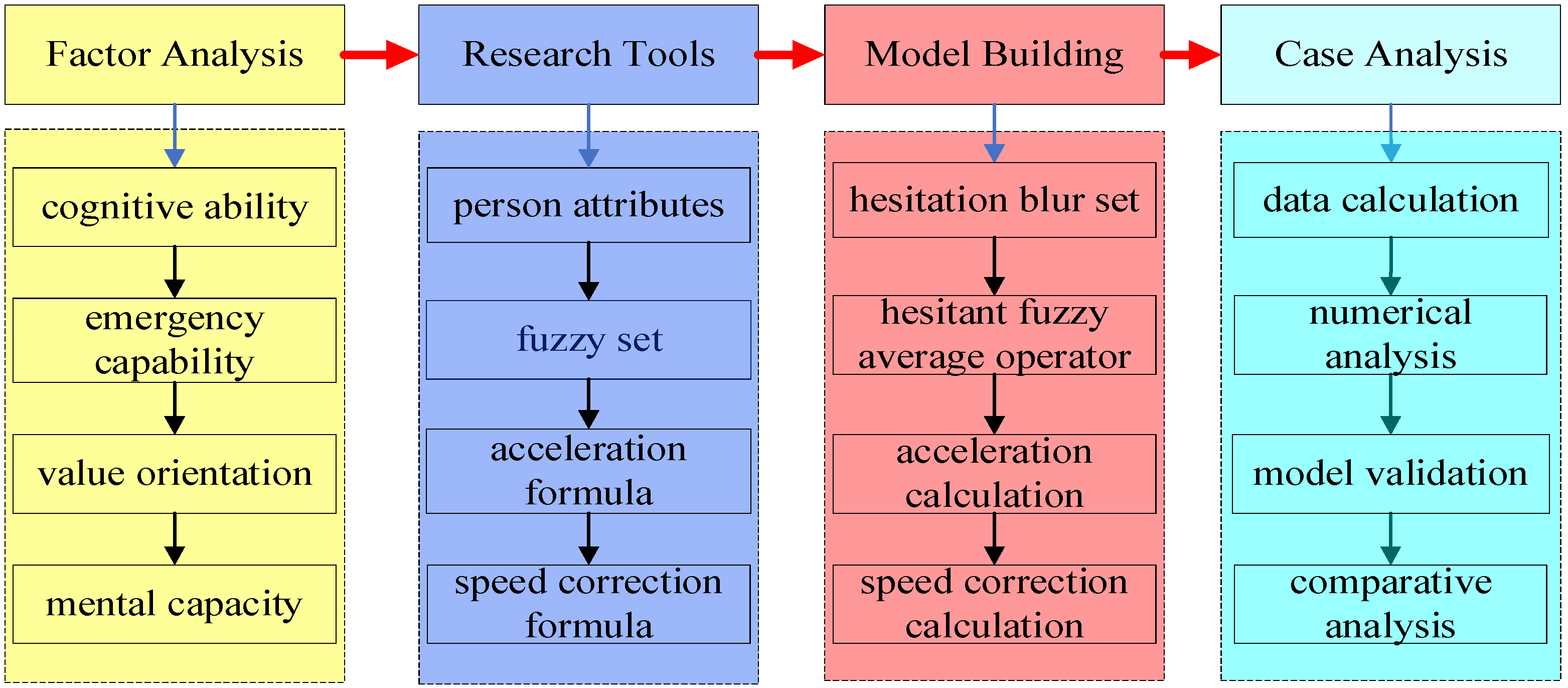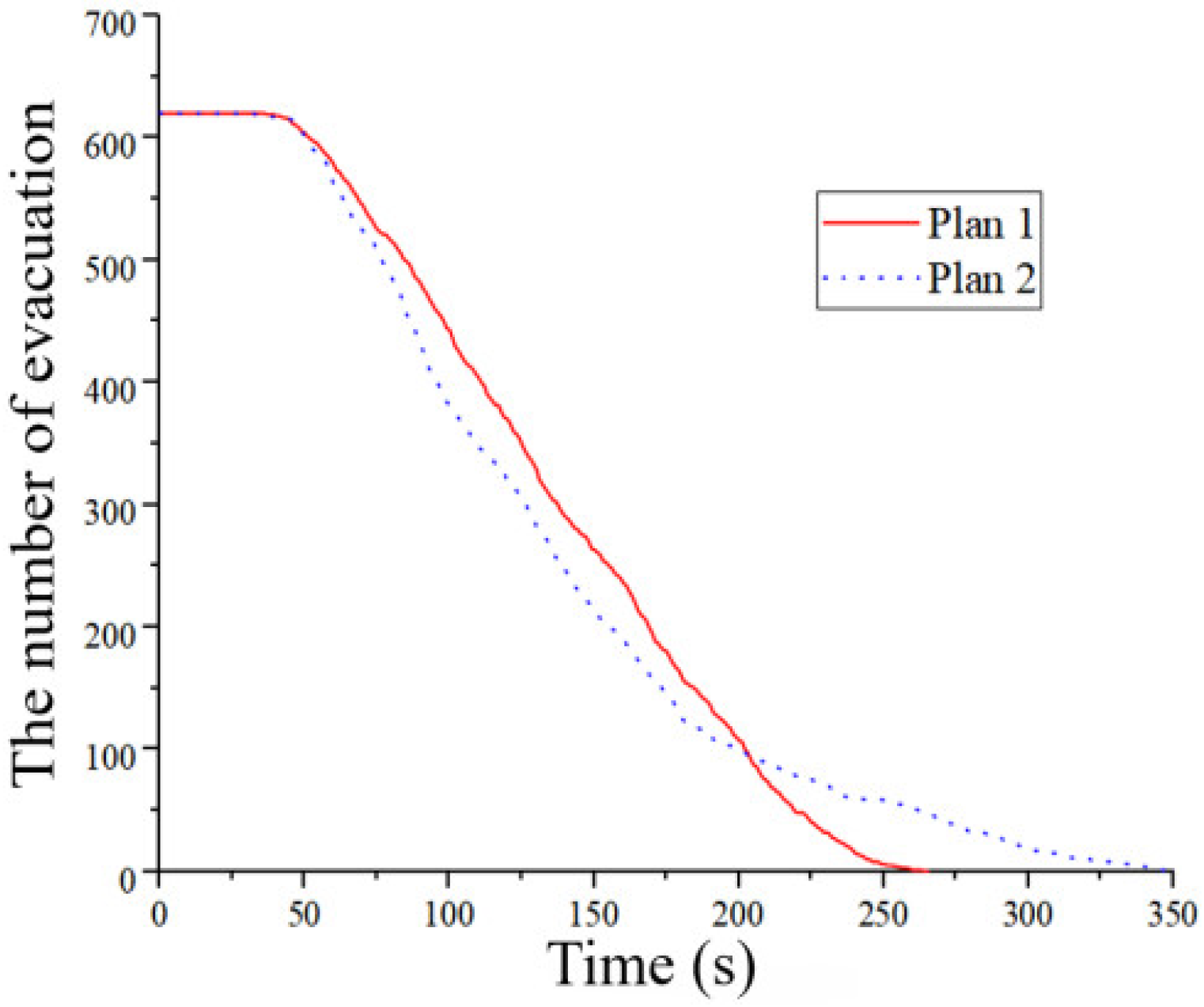A Ship Fire Escape Speed Correction Method Considering the Influence of Crowd Interaction
Abstract
:1. Introduction
1.1. Literature Review
1.2. Objective Contribution
2. Research Foundation
2.1. Research Idea
2.2. Analysis of Key Factors for the Escape of Personnel on Board
2.3. Research Tools
3. Model Formulation
3.1. Consider Different Attributes and the Speed Correction Model of the Crowd
3.2. Supplement and Description
- (i)
- is regarded as the maximum value andas the minimum value, soare substituted into Equation (8) to obtain simplified Equation (10).where,
- (ii)
- Similarly,is regarded as the maximum value andas the minimum value, socan be substituted into Equation (8) to obtain simplified Equation (10).
4. Simulation Example
4.1. Personnel Evacuation Speed Correction
4.2. Simulation Model Construction
4.3. Comparative Analysis of Evacuation Results
5. Conclusions
Author Contributions
Funding
Institutional Review Board Statement
Informed Consent Statement
Data Availability Statement
Conflicts of Interest
References
- Zhang, T. Investigation and Research Report on Ship Fire. WSRJ 2020, 6, 16–23. [Google Scholar]
- Kim, B.; Hwang, K.I. Text mining techniques to identify causes and hazards of ship fire accidents. J. Mar. Eng. Technol. 2020, 44, 189–195. [Google Scholar] [CrossRef]
- Tong, D.; Canter, D. The decision to evacuate: A study of the motivations which contribute to evacuation in the event of fire. Fire Saf. J. 1985, 9, 257–265. [Google Scholar] [CrossRef]
- Kinateder, M.T.; Kuligowski, E.D.; Reneke, P.A.; Peacock, R.D. Risk perception in fire evacuation behavior revisited: Definitions, related concepts, and empirical evidence. Fire Sci. Rev. 2015, 4, 1. [Google Scholar] [CrossRef] [PubMed] [Green Version]
- Treuille, A.; Cooper, S.Z.; Popović, Z. Continuum crowds. ACM Trans. Graph. 2006, 25, 1160–1168. [Google Scholar] [CrossRef]
- Helbing, D.; Farkas, I.; Vicsek, T. Simulating dynamical features of escape panic. Nature 2000, 407, 487–490. [Google Scholar] [CrossRef] [Green Version]
- Helbing, D.; Farkas, I.J.; Vicsek, T. Freezing by heating in a driven mesoscopic system. Phys. Rev. Lett. 2000, 84, 1240. [Google Scholar] [CrossRef] [Green Version]
- Wang, Y.; Kyriakidis, M.; Dang, V.N. Incorporating human factors in emergency evacuation–An overview of behavioral factors and models. Int. J. Disaster Risk Reduct. 2021, 60, 102254. [Google Scholar] [CrossRef]
- Wang, H.; Xu, T.; Li, F. A novel emergency evacuation model of subway station passengers considering personality traits. Sustainablity 2021, 13, 10463. [Google Scholar] [CrossRef]
- Hu, Y.L.; Wang, X.; Wang, F.Y. A quantitative study of factors influence on evacuation in building fire emergencies. IEEE Trans. Comput. Soc. Syst. 2018, 5, 544–552. [Google Scholar] [CrossRef]
- Feng, J.N.; Wang, Q.F. Emergency safety evacuation decision based on dynamic Gaussian Bayesian network. Mater. Sci. Eng. 2019, 688, 055076. [Google Scholar] [CrossRef]
- Lovreglio, R.; Ronchi, E.; Nilsson, D. An Evacuation Decision Model based on perceived risk, social influence and behavioural uncertainty. Simul. Model. Pract. Theory 2016, 66, 226–242. [Google Scholar] [CrossRef]
- Peng, M.L.; Liu, X.X.; Chen, Q. Two-layer decision-making model for HRB emergency evacuation route based on BIM. Comput. Simul. 2021, 38, 471–475. [Google Scholar]
- Sun, D.; Zhang, L.P.; Su, Z.F. Evacuate or Stay? A Typhoon Evacuation Decision Model in China Based on the Evolutionary Game Theory in Complex Networks. Int. J. Environ. Res. Public Health 2020, 17, 682. [Google Scholar] [CrossRef] [Green Version]
- Tian, Y.; Zhou, T.S.; Yao, Q.; Zhang, M.; Li, J.S. Use of an agent-based simulation model to evaluate a mobile-based system for supporting emergency evacuation decision making. J. Med. Syst. 2014, 38, 149. [Google Scholar] [CrossRef] [PubMed]
- Koo, J.; Kim, B.I.; Kim, Y.S. Estimating the effects of mental disorientation and physical fatigue in a semi-panic evacuation. Expert. Syst. Appl. 2014, 41, 2379–2390. [Google Scholar] [CrossRef]
- Chen, L.; Zheng, Q.; Li, K.; Li, Q.R. Emergency evacuation from multi-exits rooms in the presence of obstacles. Phys. Scripta 2021, 96, 115208. [Google Scholar] [CrossRef]
- Jeon, G.Y.; Na, W.J.; Hong, W.H.; Lee, J.K. Influence of design and installation of emergency exit signs on evacuation speed. J. Asian Archit. Build. Eng. 2019, 18, 104–111. [Google Scholar] [CrossRef]
- Yu, L.; Deng, T.; Wang, M.; Li, Q.; Xu, X.X. Passengers’ evacuation from a fire train in railway tunnel. Int. J. Rail. Transp. 2019, 7, 159–172. [Google Scholar] [CrossRef]
- Jia, L.; Yun, C. Simulation on staffs evacuation behavior in plant fire emergencies. Syst. Res. Behav. Sci. 2014, 31, 527–536. [Google Scholar] [CrossRef]
- Kinsey, M.J.; Gwynne, S.M.V.; Kuligowski, E.D.; Kinateder, M. Cognitive biases within decision making during fire evacuations. Fire Technol. 2019, 55, 465–485. [Google Scholar] [CrossRef]
- Zadeh, L.A. Fuzzy sets. Inf. Control 1965, 8, 338–353. [Google Scholar] [CrossRef] [Green Version]
- Torra, V. Hesitant fuzzy sets. Int. J. Intell. Syst. 2010, 25, 529–539. [Google Scholar] [CrossRef]
- Rodríguez, R.M.; Martínez, L.; Torra, V.; Xu, Z.S.; Herrera, F. Hesitant fuzzy sets: State of the art and future directions. Int. J. Intell. Syst. 2014, 29, 495–524. [Google Scholar] [CrossRef]
- Xia, M.; Xu, Z. Hesitant fuzzy information aggregation in decision making. Int. J. Approx. Reason. 2011, 52, 395–407. [Google Scholar] [CrossRef] [Green Version]
- No, H.; Cho, A.; Kee, C. Attitude estimation method for small UAV under accelerative environment. GPS Solut. 2015, 19, 343–355. [Google Scholar] [CrossRef]
- Xu, M.; Wang, G. Research on the applicability of ship motion and acceleration formulas to fatigue strength assessment of container ships. China Ship Build. 2022, 63, 166–175. [Google Scholar]
- Yuan, C.Y.; Wang, K.; Chen, H.Y.; Liu, X.; Lang, Y.J. Research on fire evacuation speed correction method based on personnel psychological-environmental factors. China Saf. Prod. Sci. Technol. 2020, 16, 112–118. [Google Scholar]
- Xu, Z.; Yang, X.K.; Zhao, X.H.; Li, L.J. Driver perception reaction time under the emergency evacuation situation. J. Chongqing Univ. 2011, 34, 54–60. [Google Scholar]
- Koshiba, Y.; Suzuki, Y. Factors affecting post-evacuation behaviors following an earthquake: A questionnaire-based survey. Int. J. Disaster Risk Reduct. 2018, 31, 548–554. [Google Scholar] [CrossRef]





| Variable | Problem Setting | Options |
|---|---|---|
| basic information of personnel | gender | men; women |
| age | under 20 years old; 20–60 years old: over 60 years old | |
| cognitive ability | education level | high school diploma and below; college degree; bachelor degree; Master degree and above |
| emergency capability | escape response when hearing a fire alarm | look around and judge for yourself; |
| ask others to determine the direction of escape; | ||
| escape immediately; | ||
| observe the behavior of others | ||
| value orientation | will you escape with valuables | no; possibly; not sure, must |
| psychological endurance | the level of panic at hearing a fire alarm | no panic; low panic; moderate panic; extreme panic |
| Influencing Factors | Adult Male (20–60 Years Old) | Adult Female (20–60 Years Old) | Elderly (Over 60 Years Old) | Children (Under 20 Years Old) | |
|---|---|---|---|---|---|
| Cognitive ability | high school diploma or below | 3% | 18% | 14% | 0% |
| college degree | 54% | 53% | 43% | 54% | |
| bachelor degree | 33% | 24% | 29% | 46% | |
| master degree and above | 10% | 5% | 14% | 0% | |
| The emergency ability | look around and judge for yourself | 29% | 22% | 43% | 38% |
| ask others to determine the direction of escape | 37% | 36% | 14% | 31% | |
| escape immediately | 20% | 31% | 43% | 23% | |
| observe other people’s behavior | 14% | 11% | 0% | 8% | |
| The value orientation | no | 58% | 58% | 68% | 70% |
| probably | 15% | 10% | 8% | 10% | |
| not sure | 19% | 22% | 16% | 10% | |
| must | 8% | 10% | 8% | 10% | |
| Mental endurance | no panic | 17% | 22% | 29% | 8% |
| low panic | 32% | 29% | 43% | 31% | |
| moderate panic | 29% | 29% | 14% | 38% | |
| extreme panic | 12% | 20% | 14% | 23% | |
| Plan | Evacuation Time (s) | Evacuation Efficiency (Rate of the Curve) | Remaining Staff |
|---|---|---|---|
| 1 | 265.28 | high | 0 |
| 2 | 349.03 | low | 0 |
Publisher’s Note: MDPI stays neutral with regard to jurisdictional claims in published maps and institutional affiliations. |
© 2022 by the authors. Licensee MDPI, Basel, Switzerland. This article is an open access article distributed under the terms and conditions of the Creative Commons Attribution (CC BY) license (https://creativecommons.org/licenses/by/4.0/).
Share and Cite
Li, J.; Liu, W.; Zhang, F.; Li, T.; Wang, R. A Ship Fire Escape Speed Correction Method Considering the Influence of Crowd Interaction. Mathematics 2022, 10, 2749. https://doi.org/10.3390/math10152749
Li J, Liu W, Zhang F, Li T, Wang R. A Ship Fire Escape Speed Correction Method Considering the Influence of Crowd Interaction. Mathematics. 2022; 10(15):2749. https://doi.org/10.3390/math10152749
Chicago/Turabian StyleLi, Jingyuan, Weile Liu, Fangwei Zhang, Taiyang Li, and Rui Wang. 2022. "A Ship Fire Escape Speed Correction Method Considering the Influence of Crowd Interaction" Mathematics 10, no. 15: 2749. https://doi.org/10.3390/math10152749





